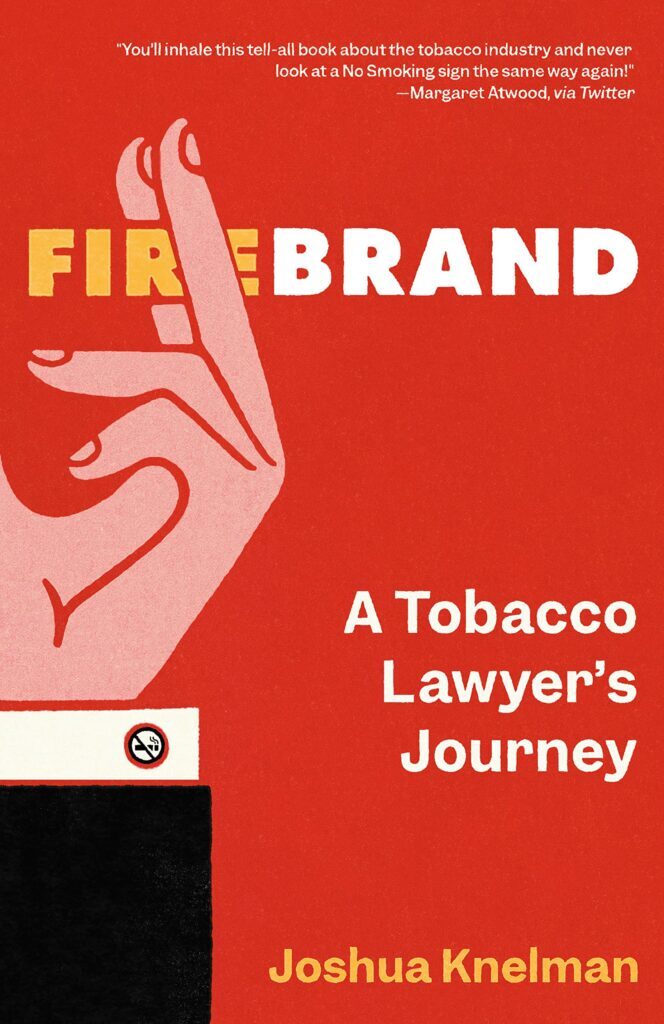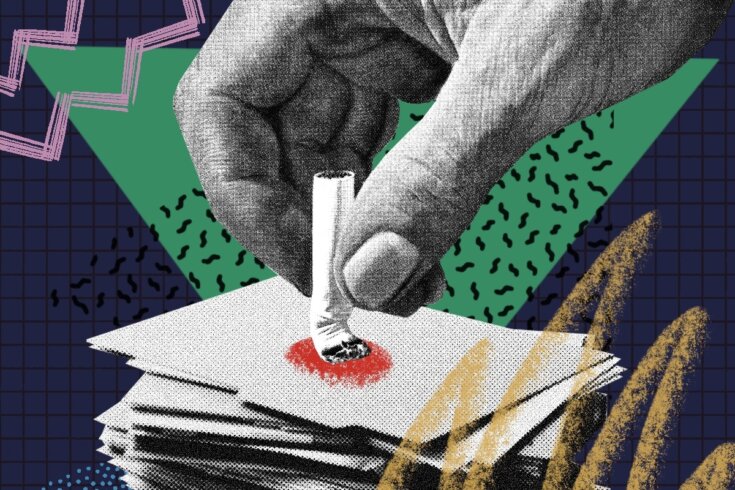 Excerpted from Firebrand: A Tobacco Lawyer’s Journey by Joshua Knelman. Copyright © 2022 Joshua Knelman. Published by Penguin Random House Canada. Reproduced by arrangement with the publisher. All rights reserved.
Excerpted from Firebrand: A Tobacco Lawyer’s Journey by Joshua Knelman. Copyright © 2022 Joshua Knelman. Published by Penguin Random House Canada. Reproduced by arrangement with the publisher. All rights reserved.People who haven’t smoked cannot possibly understand the personal satisfaction derived from smoking a cigarette.
For many smokers, it is tantamount to having an orgasm: the exhilaration of unwrapping a vacuum-sealed package of cigarettes, popping the foil, patting the pack against your arm, and then smelling the fresh tobacco. You take the filter of the unlit cigarette and roll it around your lips. Strike the match, light the cigarette, inhale, and get that first taste of the tobacco, the flavours, and the additives.
The rush of the nicotine into the bloodstream, which numbs your senses, is unmatched by any other legal barbiturate or narcotic available on the market in the Western world. It’s the feeling of the tar moving down the back of the throat, burning the esophagus, of holding the smoke in for a few seconds, and then blowing it out through your nose or mouth. You can’t possibly explain the pleasure achieved from this repetitive exercise. We’re talking about the real smokers here. They know. The joy derived by smokers is unparalleled. Alcohol doesn’t come close.
This seemingly simple device—the cigarette—elegantly delivers a drug by the simple act of breathing in and is perfectly designed to addict its taker. You smoke one, and then, almost mysteriously, you want another and another. Anyone who has ever become a smoker knows this feeling of longing—and of receiving the pleasure of giving in to that longing.
Once you start, every cigarette is satisfying. And, thanks to the Industrial Revolution and mechanized production, every cigarette promises precisely the same experience. A specified amount of nicotine is delivered to your brain, releasing dopamine, and in that moment, you are satisfied—with morning coffee, at your lunch break, after a difficult discussion, after dinner, after drinks, after sex, in a stolen moment before you fall asleep. For a smoker, there is no end to the desire to smoke. You just wish it didn’t have so many harmful effects.
Up until the mid-1960s, tobacco companies spent hundreds of millions of dollars a year advertising their brands, without criticism and through all available channels: television, newspapers, magazines, radio, billboards, and, of course, by sponsoring supersized sporting and cultural events. It was the golden age of smoking. Think Mad Men. Obscene amounts of money flowed, and rooms were cloudy blue.
In the 1940s and ’50s, it wasn’t uncommon for doctors to smoke during patient consultations; it also wasn’t uncommon for them to prescribe cigarettes as remedies for various ailments—to soothe anxiety, promote weight loss, and help with depression. Smoking was portrayed in the media as being glamorous, with health benefits, and as a surefire way to get you laid.
But, in the late 1940s, before almost anyone else in the world, a doctor named Richard Doll gathered strong scientific evidence proving that smoking was a gamble, one in which a person could lose his or her life. Doll was born in Hampton, Greater London, in 1912 and served as an officer in World War II even as he trained in medicine. He enjoyed smoking cigarettes and did so about five times a day. After the war, he returned to London and attended King’s College, where he continued to pursue a career in medical research. He went on to become one of the world’s leading epidemiologists.
By 1949, Doll was working with the Medical Research Council alongside Austin Bradford Hill, a fellow epidemiologist in London. The two researchers were trying to figure out why lung-cancer rates in Britain had spiked in the first half of the twentieth century. They were intent on finding the source of the carcinogens that were invading human bodies all around them. It was old-fashioned detective work.
At first, the two doctor-detectives thought it might be because of the type of tar being used to expand Britain’s road system, or other synthetic environmental pollutants popular during the postwar boom. Their method was simple and direct: they approached lung-cancer patients in London hospitals and asked them to take part in a survey. The patients who agreed were asked about their family histories, diets, employment, and previous diseases they’d incurred. Of the 649 patients who had contracted lung cancer, it turned out, only two were nonsmokers.
Doll promptly gave up smoking his five cigarettes a day and was spurred on to find out more about the potentially deadly link between tobacco and lung cancer. In 1951, Doll and Hill released their first report, in which they posited the relationship between smoking cigarettes and lung cancer. The report wasn’t a hit among their peers; no one really wanted to hear the bad news. After all, a lot of people—including in the medical community—loved smoking. Doctors and researchers didn’t want to entertain the idea that lighting up their favourite consumer brands may, in fact, be dimming once-bright futures.
Doll and Hill regrouped and pushed forward. This time, instead of targeting lung-cancer patients, they chose a different group to survey: doctors who smoked. They wrote to almost 60,000 British doctors—and we’re not talking about email here; these were individual letters sent through the Royal Mail—asking them about their smoking habits and issues related to their health. It was an ingenious plan. Doll’s strategy: if you, the medical community, don’t trust our previous findings, here’s the data gathered from the very doctors who safeguard our nation’s health.
Over 40,000 doctors wrote back, agreeing to take part in their smoking study. Doll and Hill published their new peer-reviewed research results in a 1954 issue of The British Medical Journal.
The report was groundbreaking. Just as their earlier research had indicated, the new report firmly established the link between smoking cigarettes and lung cancer. It was remarkable, undeniable, and this time had an impact: medical researchers, scientists, and government agencies took note, on both sides of the Atlantic. Indeed, the report revealed a truth that many country doctors were already aware of—rural medics already had a nickname for cigarettes: coffin nails.
It was Doll and Hill, though, who had established the strongest scientific link so far between tobacco use and lung cancer, and their work cleared the way, ten years later, for the scientific might of America’s government apparatus to be unleashed on its citizens.
Everything changed in 1964. That’s when the surgeon general released his report containing US-based major scientific research: for the first time, America’s top doctor, along with an influential cohort of health scientists and medical researchers, categorically linked tobacco consumption to a variety of serious illnesses, cancer included.
Most people didn’t know the name of the man who published that report: Luther Terry, the ninth surgeon general, who served in that position from 1961 to 1965. Terry’s report explained what everyone now takes for granted: that smoking can kill you. Ripples from the report eventually built into a massive wave of antismoking sentiment that swept through mainstream society. Starting in 1969, all cigarette packs in the US had to bear the line “Warning: The Surgeon General Has Determined That Cigarette Smoking Is Dangerous to Your Health.”
The surgeon general’s 1964 report became, probably, the most often quoted publication in the history of the printed word. Phrases from it were printed, in almost every language in the world, in the form of warnings on billions of packs of cigarettes manufactured and sold each year.
It took more than three decades for the impact of Terry’s report to slam into the US tobacco industry. In 1998, an epic legal settlement—called the Master Settlement Agreement—was negotiated between the four largest tobacco companies in the US and the attorneys general of forty-six states.
Michael Mann’s 1999 movie, The Insider, chronicles some of the dramatic backstory. It involves a tobacco executive named Jeffrey Wigand, who served as head of research and development for Brown & Williamson Tobacco and who became famous as a whistleblower on an episode of CBS’s flagship investigative news program 60 Minutes. Wigand claimed on 60 Minutes that Big Tobacco knew about the harmful effects of smoking long before Terry’s report in 1964, that it knew nicotine was addictive, and that it had been manipulating levels of the drug in its products. The 60 Minutes episode with Wigand aired in 1995, and three years later, to avoid decades of lawsuits from dozens of US states seeking to recover tobacco-related health care costs, Big Tobacco agreed to a deal: the industry would pay annual amounts in perpetuity—with a minimum of $206 billion (US) due in the first twenty-five years.
That’s a number that would destroy almost any industry in the world—and more than a few nations—were it suddenly collected. Why would a major American industry agree to what seemed like such a raw deal? After all, their product was 100 percent legal and quite popular.
Let’s talk automobiles for a moment. In the 1970s, Ford Motor Company created the Ford Pinto, intended as a car for the masses. The Pinto made it all the way to the assembly line. Cars were ready to be shipped when, in Ford’s internal-testing phase, it became clear that under certain circumstances, where the car was involved in a side-impact collision, a design flaw in the fuel line could cause the Pinto to catch fire.
Instead of recalling the cars and fixing the problem, the court hearing the case was told, Ford had pursued a different business strategy. Ford calculated the likely damages the company would have to pay customers and their families in the event of collision accidents and compared them with the cost of a recall and full redesign. It concluded that it would be cheaper to pay the claims and continue with the status quo rather than pull the plug and start again. An internal Ford document with grim calculations was paraded in front of the court and its jury. Not surprisingly, as Pintos were sold, people started being injured, and some were dying in fiery explosions.
In this particular case, Grimshaw v. Ford Motor Company, the court awarded the plaintiff, Richard Grimshaw, punitive damages of $120 million (US). That was a surprise. No one had expected a number that big.
The concept of punitive damages is what it implies: the legal system imposes punishment beyond the normal tariff damages and equal to the loss suffered. The Pinto case created a new fear for corporations. It proved that courts would punish a company for acting badly. If financial pain affected behaviour, the larger the company, the higher the punitive damages had to be.
Ford, let’s keep in mind, was a very large company, but not as large as all four major American tobacco companies combined. Hence, a question began to pop up in legal circles in the aftermath of the Pinto verdict: What would happen if those large tobacco companies were ever faced with punitive damages in a US court of law?
No one knew the answer to that multibillion-dollar question—or was it a trillion-dollar question?
By the 1990s, the mounting threat of litigation against the tobacco industry was starting to cause internal concern. An incredible payday awaited some ambitious law firm, but how would you prove the industry had failed to adequately warn about the risks associated with cigarettes? You’d have to be an ostrich living in North Korea not to know that smoking caused cancer, that it was bad for you, and that it could kill you. That was thanks to Luther Terry’s report and to those warnings printed on billions of packs of cigarettes.
But, when Wigand entered the public arena in the mid-1990s, he had proof: documents and experience. Now it was a different ball game. Now it wasn’t about failure to warn: it was about failure to put forward all the evidence the manufacturer was keeping to itself. This was called “withholding pertinent information.”
Wigand’s revelation was of particular interest to US states, which were spending fortunes covering health care costs for millions of Americans who smoked. After Wigand appeared on American prime-time TV, dozens of states started working together, organizing a strategy to go after tobacco companies in pack formation.
The US was an interesting legal jurisdiction in that it had trial by jury for civil matters. So here’s a scenario: you took a sick person suffering from emphysema—or any other of the 250 illnesses known to be related to tobacco use—and stuck that individual in a courtroom in view of a jury. That person was hooked up to a respirator and seated across the floor from a bunch of tobacco executives in expensive suits. You pulled at the heartstrings of the jury by making the case that had it not been for the horrific products this industry manufactured, this sick person—a God-fearing and hard-working American—would be healthy and happy.
How do you think the jury would rule?
Some lawyers imagined that if they could show the tobacco companies had been negligent, they could win a fortune larger than the GDPs of some nations. It was an Erin Brockovich moment waiting to happen.
Let’s throw in an X factor: the political pressure bearing down on the US federal government.
The Clinton administration was in power, and the president and his advisers worried about the looming showdown between Big Tobacco and the US states. The administration didn’t want to be in charge while a major historic industry was burned to the ground.
To explore a Hail Mary possibility, the government entered into a complex dialogue with the industry that stretched over two years, and here was the final offer: in exchange for protection from US states intent on suing Big Tobacco, the industry would agree to a very large payout and also agree to voluntary concessions around the sales of most of its products and much of its advertising.
In the wake of Wigand and the hunt by the attorneys general, the tobacco industry didn’t have a lot of options. So it agreed to dismantle its lobby in Washington; it agreed to impose marketing and advertising restrictions on its products; and it agreed to increase consumer awareness programs that explained the dangers of smoking—for example, the nonprofit Truth Initiative, which was based in Washington and was dedicated to educating youth on the dangers of smoking. In addition, the industry would restrict access to tobacco products.
A manufacturer restricting consumer access to its product—that was rare in America.
Perhaps most importantly, the industry agreed to a payment of $206 billion (US) over the first twenty-five years. This massive amount of money would be used to fund state health care and antitobacco programs. All big tobacco companies were “encouraged” to participate, and they did. Indeed, they had no choice.
Here’s what the industry gained from the deal: all pending lawsuits from all US states immediately went away, with no possibility of future litigation. It was an expensive legal miracle. The price of the product went up, and thus the Master Settlement Agreement payments (which added up to those billions of dollars) were passed on to the consumer by the tobacco companies. It was Jill and Joe Smoker who were actually footing the massive bill—and over a long period of time. The extra charge on each pack wasn’t considered a tax.
This was a brilliant, made-in-America solution for a consumer product like no other: 100 percent legal but proven deadly.






